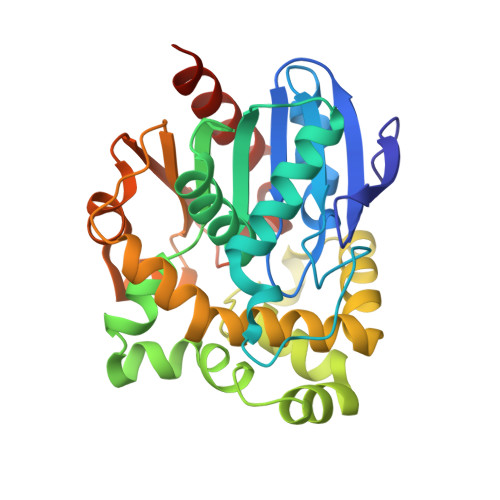Substrate specificity of fluoroacetate dehalogenase: an insight from crystallographic analysis, fluorescence spectroscopy, and theoretical computations
Nakayama, T., Kamachi, T., Jitsumori, K., Omi, R., Hirotsu, K., Esaki, N., Kurihara, T., Yoshizawa, K.(2012) Chemistry 18: 8392-8402
- PubMed: 22674735
- DOI: https://doi.org/10.1002/chem.201103369
- Primary Citation of Related Structures:
3B12 - PubMed Abstract:
The high substrate specificity of fluoroacetate dehalogenase was explored by using crystallographic analysis, fluorescence spectroscopy, and theoretical computations. A crystal structure for the Asp104Ala mutant of the enzyme from Burkholderia sp. FA1 complexed with fluoroacetate was determined at 1.2 Å resolution. The orientation and conformation of bound fluoroacetate is different from those in the crystal structure of the corresponding Asp110Asn mutant of the enzyme from Rhodopseudomonas palustris CGA009 reported recently (J. Am. Chem. Soc. 2011, 133, 7461). The fluorescence of the tryptophan residues of the wild-type and Trp150Phe mutant enzymes from Burkholderia sp. FA1 incubated with fluoroacetate and chloroacetate was measured to gain information on the environment of the tryptophan residues. The environments of the tryptophan residues were found to be different between the fluoroacetate- and chloroacetate-bound enzymes; this would come from different binding modes of these two substrates in the active site. Docking simulations and QM/MM optimizations were performed to predict favorable conformations and orientations of the substrates. The F atom of the substrate is oriented toward Arg108 in the most stable enzyme-fluoroacetate complex. This is a stable but unreactive conformation, in which the small O-C-F angle is not suitable for the S(N)2 displacement of the F(-) ion. The cleavage of the C-F bond is initiated by the conformational change of the substrate to a near attack conformation (NAC) in the active site. The second lowest energy conformation is appropriate for NAC; the C-O distance and the O-C-F angle are reasonable for the S(N) 2 reaction. The activation energy is greatly reduced in this conformation because of three hydrogen bonds between the leaving F atom and surrounding amino acid residues. Chloroacetate cannot reach the reactive conformation, due to the longer C-Cl bond; this results in an increase of the activation energy despite the weaker C-Cl bond.
Organizational Affiliation:
Institute for Materials Chemistry and Engineering and International Research Center for Molecular Systems, Kyushu University, Fukuoka 819-0395, Japan.
















